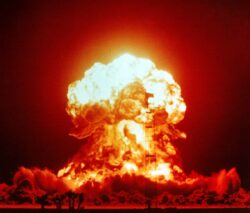 By Carl Conetta, 14 March 2021
By Carl Conetta, 14 March 2021
Between 1945 and 1962, the United States conducted 210 atmospheric nuclear tests. Many of these can viewed online in the nuclear test video archive maintained by the Lawrence Livermore National Laboratory. (A fuller assessment of the films and their use is found here: “LLNL releases newly declassified test videos.“)
By some estimates, the US and other (mostly Soviet) tests produced in excess of 400,000 additional cancer deaths worldwide (Comprehensive Nuclear-Test-Ban Treaty, “General overview of the effects of nuclear testing“). But this represents only part of the risks and costs of premising security on these weapons. The cost of actually using them, intentionally or by accident, would be much much greater.
In 2019, Princeton University’s Program on Science and Global Security simulated the impact of a full-scale nuclear war between Russia and USA/NATO based on the 2019 US nuclear war planning guidance, Joint Publication 3-72: Nuclear Operations. The analysts estimated that the immediate impact of the exchanges would be 34 million dead and 57.5 million injured. Of course, the longer-term impact would be much greater due to terminal injuries, radiation effects, pandemic disease, climate effects, and the failure of medical systems and other essential services and infrastructure.
(One tool used in the study was the “Nuke Map” produced by Alex Wellerstein, Director of Science and Technology Studies at the Stevens Institute of Technology. The map is an interactive tool allowing estimates of the destructive effects of different types and yields of nuclear blasts.)
Our present circumstance: Today the USA and Russia still each hold more than 6,000 nuclear warheads. Other nations hold 1,200 cumulatively: China, France, India, Israel, North Korea, Pakistan, and the UK. (Arms Control Association, “Nuclear Weapons: Who Has What at a Glance“).
Most weapons in the US arsenal currently range in yield between 150-kilotons (thousands of tons of TNT equivalent) and 600-kilotons, although some can dial up to 1.2 megatons. The US bombs that destroyed Hiroshima and Nagasaki in 1945 are estimated to have had 15-kiloton and 21-kiloton yields respectively. The largest test ever conducted by the USA was Castle Bravo in 1954, yielding approximately 15 megatons. The largest test yield ever resulted from the Soviet “Tsar Bomba” test: 50 megatons.
Today, while most efforts at nuclear arms control and reduction have stalled or been rescinded, nuclear weapon modernization programs are surging. While Barack Obama began his presidency pledging progress toward a world without nuclear weapons, and did win congressional support for the New Start treaty, this came at the price of a nuclear weapon sustainment and modernization program now estimated to cost more than $1.5 trillion over the next 30 years.
Currently a new qualitative arms race is underway, commensurate with “big power competition,” as both the United States and Russia seek to neutralize or surmount the advantages each perceives in the other’s global position and posture. In this sense, we have turned the clock back 30 years to a period when international competition involved existential threats.
If one believes that the awful power of nuclear weapons can reliably deter their use while also serving to limit war generally, then it might seem reasonable to accept the moral and financial burden they impose. However, these weapons incur additional costs that serve to countervail their deterrence effects.
Framing the world in terms of nations that permanently hold each other at threat of near-instantaneous extinction gravely distorts all international relations, shrouding them in persistent fear and distrust. This undermines global cooperation and provides no sure foundation for stability, much less security and peace. Indeed, fear and distrust are principal drivers of contention and war. In this sense, nuclear arsenals contribute to the conflict potentials that they are supposed to contain.
Whether one believes in the deterrent power of these weapons or not, their other longer-term risks and negative effects makes essential a determined commitment to increase international cooperation, confidence-building measures, and progress in nuclear arms reduction. Looking forward, the hope for a reliable peace depends not on the bulwark of mutual assured destruction, but on lowering levels of international threat and building accord among nations, whenever and however we can.
* The title of this post derives from J. Robert Oppenheimer’s reflection on witnessing the first atomic bomb explosion in July 1945. He shared this brief reflection on a TV broadcast in 1965: https://youtu.be/ZardNuQ_fE0
